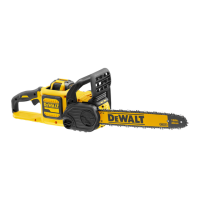13
ENGLISH
• Young children and the infirm. This appliance is not
intended for use by young children or infirm persons
withoutsupervision.
• This product is not intended for use by persons (including
children) suffering from diminished physical, sensory or
mental abilities; lack of experience, knowledge or skills
unless they are supervised by a person responsible for their
safety. Children should never be left alone with thisproduct.
ASSEMBLY AND ADJUSTMENTS
WARNING: To reduce the risk of serious personal
injury, turn tool off and disconnect battery pack
before making any adjustments or removing/
installing attachments or accessories. An accidental
start-up can causeinjury.
WARNING: Use only DeWALT battery packs andchargers.
Inserting and Removing the Battery Pack
from the Tool (Fig. C–E)
NOTE: Make sure your battery pack
7
is fullycharged.
To Install the Battery Pack into the Tool
1. Align the battery pack
7
with the rails inside the tool
(Fig.C).
2. Slide it into the tool until the battery pack is firmly seated
and ensure that you hear the lock snap intoplace.
To Remove the Battery Pack from the Tool
1. Press the release button
15
and firmly pull the battery pack
out of the toolhandle (Fig. D).
2. Insert battery pack into the charger as described in the
charger section of thismanual.
Fuel Gauge Battery Packs (Fig. E)
Some DeWALT battery packs include a fuel gauge which
consists of three green LED lights that indicate the level of
charge remaining in the batterypack.
To actuate the fuel gauge, press and hold the fuel gauge button
17
. A combination of the three green LED lights will illuminate
designating the level of charge left. When the level of charge
in the battery is below the usable limit, the fuel gauge will not
illuminate and the battery will need to berecharged.
NOTE: The fuel gauge is only an indication of the charge left on
the battery pack. It does not indicate tool functionality and is
subject to variation based on product components, temperature
and end-userapplication.
ASSEMBLY
Installing the Guide Bar and Saw Chain
(Fig. A, F–H, K)
CAUTION: Sharp chain. Always wear protective gloves
when handling the chain. The chain is sharp and can cut
you when it is notrunning.
WARNING: Sharp moving chain. To prevent accidental
operation, ensure that battery is removed from the tool
before performing the following operations. Failure to do
this could result in serious personalinjury.
The saw chain
5
and guide bar
4
are packed separately in the
carton. The chain has to be attached to the bar, and both must
be attached to the body of thetool.
• Place the saw on a flat, firmsurface.
• Flip up locking lever and rotate the bar adjust locking
knob
8
counterclockwise as shown in FigureF to remove
sprocket cover
6
.
• Wearing protective gloves, grasp the saw chain
5
and wrap
it around the guide bar
4
, ensuring the teeth are facing the
correct direction (see FigureK)
• Ensure the chain is properly set in the slot around the entire
guidebar.
• Place the saw chain around the sprocket
18
. While lining
up the slot on the guide bar with chain tensioning pin
20
, and the bolt
19
, on the base of the tool as shown in
FigureG.
• Once in place, hold the bar still, replace sprocket cover
6
. Make sure tool-free tension assembly bolt hole on the
cover lines up with the bolt
19
, in the main housing. Flip
up locking lever and rotate the bar adjust locking knob
8
clockwise until it clicks, then loosen knob one full turn, so
that the saw chain can be properlytensioned.
• Rotate the chain tensioning knob
9
clockwise to increase
tension as shown in FigureH. Make sure the saw chain
5
is
snug around the guide bar
4
. Tighten the bar adjust locking
knob until it clicks. The bar is secure after three audible clicks
are heard. Further tightening is notrequired.
Adjusting Chain Tension (Fig. A, I )
CAUTION: Sharp chain. Always wear protective gloves
when handling the chain. The chain is sharp and can cut
you when it is notrunning.
WARNING: Sharp moving chain. To prevent accidental
operation, ensure that battery is removed from the tool
before performing the following operations. Failure to do
this could result in serious personalinjury.
• With the saw on a flat, firm surface, check the saw chain
5
tension. The tension is correct when the chain snaps back
after being pulled 3mm away from the guide bar
4
with
light force from the index finger and thumb as shown in
FigureI. There should be no “sag” between the guide bar
and the chain on the underside as shown in FigureI.
• To adjust saw chain tension, flip up locking tab and rotate
the bar adjust locking knob
8
counterclockwise one full
turn. Rotate the chain tensioning knob
9
clockwise until the
chain tension is correct as instructedabove.
• Do not over-tension the chain as this will lead to excessive
wear and will reduce the life of the bar andchain.
• Once chain tension is correct, securely tighten bar adjust
lockingknob.
NOTE: The bar adjust locking knob has a detent tightening
system. The sprocket cover is secure after three audible clicks
are heard. Further tightening is notrequired.

